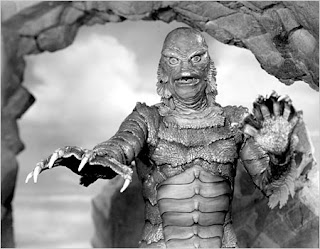Readers of this blog may wonder why I prefer the term deformed destructive being (DDB) to the plainer monster. There are 2 reasons. One is that DDB packs into itself a theory of what horror movies are about, a theory I am trying to expound. The other is that if I used monster exclusively instead of DDB, people might be confused. A case in point is Norman Bates in Psycho (1960), a DDB who might not exactly be considered a monster.
When people talk about monsters, they usually mean something fantastic and physically deformed, whether it has a scientific origin (as in Frankenstein) or a supernatural origin (as in The Mummy). Monsters usually require hideous makeup or a weird costume, such as this outfit from The Creature from the Black Lagoon:
So common is this view of monsters that people will often distinguish between a monster movie, which features a creature such as the one from the Black Lagoon, and other types of horror movies. When such a distinction is made, a movie such as Psycho is usually not classified as a monster movie. Noel Carroll, in his book The Philosophy of Horror or Paradoxes of the Heart, is not even inclined to classify it as a horror movie, because his theory of the horror film requires a monster and "Norman Bates is not a monster." Bates is not physically deformed--in fact, he is a good-looking young man--and he is not fantastic. Psychotic killers like him really do exist.
DDB theory explains why Psycho is a horror movie: because horror movies do not require monsters (in the sense of fantastic, physically deformed beings) but they do require DDBs, deformed destructive beings. The deformity of the DDB does not have to be physical. It can be spiritual (as with demons and vampires), positional (as with hybrid creatures such as werewolves), or just psychological. Norman Bates is an example of psychological deformity: he believes his dead mother is still alive and sometimes takes on her personality, with homicidal results. As long as an individual is deformed and, as a result of the deformity, destructive, that individual, like Bates, is a DDB.
I do sometimes use the terms DDB and monster interchangeably, because I don't agree that monsters have to be fantastic and physically deformed. But I prefer DDB because it is more precise.
George Ochoa
Author
Deformed and Destructive Beings: The Purpose of Horror Films


No comments:
Post a Comment